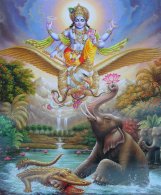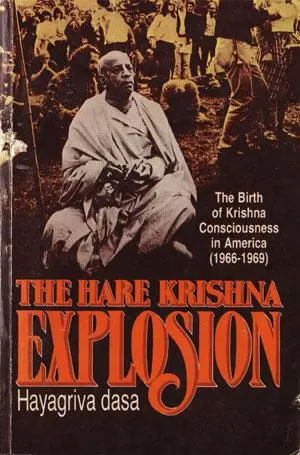click on image to enlarge
I have always loved this picture since the first time I opened the Bhagavad-gita some 42 years ago. It is a beautiful image of life in the Spiritual Sky, and also, it is a nice graphic description of the 5 types of relationships one can have with the Supreme Lord. The following is a short description, from the Introduction to the Bhagavad-gita As It Is, about the eternal nature, and the 5 types of relationships on can have with the Lord.
…In this material world we find that everything is temporary. It comes into being, stays for some time, produces some by-products, dwindles and then vanishes. That is the law of the material world, whether we use as an example this body, or a piece of fruit or anything. But beyond this temporary world there is another world of which we have information. This world consists of another nature which is sanātana, eternal. Jīva is also described as sanātana, eternal, and the Lord is also described as sanātana in the Eleventh Chapter. We have an intimate relationship with the Lord, and because we are all qualitatively one—the sanātana-dhāma, or sky, the sanātana Supreme Personality and the sanātana living entities—the whole purpose of Bhagavad-gītā is to revive our sanātana occupation, or sanātana-dharma, which is the eternal occupation of the living entity. We are temporarily engaged in different activities, but all of these activities can be purified when we give up all these temporary activities and take up the activities which are prescribed by the Supreme Lord. That is called our pure life.
…That destination is called the sanātana sky, the eternal spiritual sky. (from Introduction to Bhagavad-gita As It Is)
…The Lord informs Arjuna that this system of yoga, the Bhagavad-gītā, was first spoken to the sun-god, and the sun-god explained it to Manu, and Manu explained it to Ikṣvāku, and in that way, by disciplic succession, one speaker after another, this yoga system has been coming down. But in the course of time it has become lost. Consequently the Lord has to speak it again, this time to Arjuna on the Battlefield of Kurukṣetra.
He tells Arjuna that He is relating this supreme secret to him because he is His devotee and His friend. The purport of this is that Bhagavad-gītā is a treatise which is especially meant for the devotee of the Lord. There are three classes of transcendentalists, namely the jñānī, the yogī and the bhakta, or the impersonalist, the meditator and the devotee. Here the Lord clearly tells Arjuna that He is making him the first receiver of a new paramparā (disciplic succession) because the old succession was broken. It was the Lord’s wish, therefore, to establish another paramparā in the same line of thought that was coming down from the sun-god to others, and it was His wish that His teaching be distributed anew by Arjuna. He wanted Arjuna to become the authority in understanding the Bhagavad-gītā. So we see that Bhagavad-gītā is instructed to Arjuna especially because Arjuna was a devotee of the Lord, a direct student of Kṛṣṇa, and His intimate friend. Therefore Bhagavad-gītā is best understood by a person who has qualities similar to Arjuna’s. That is to say he must be a devotee in a direct relationship with the Lord. As soon as one becomes a devotee of the Lord, he also has a direct relationship with the Lord. That is a very elaborate subject matter, but briefly it can be stated that a devotee is in a relationship with the Supreme Personality of Godhead in one of five different ways:
1. One may be a devotee in a passive state;
2. One may be a devotee in an active state;
3. One may be a devotee as a friend;
4. One may be a devotee as a parent;
5. One may be a devotee as a conjugal lover.
Arjuna was in a relationship with the Lord as friend. Of course there is a gulf of difference between this friendship and the friendship found in the material world. This is transcendental friendship which cannot be had by everyone. Of course everyone has a particular relationship with the Lord, and that relationship is evoked by the perfection of devotional service. But in the present status of our life, we have not only forgotten the Supreme Lord, but we have forgotten our eternal relationship with the Lord. Every living being, out of many, many billions and trillions of living beings, has a particular relationship with the Lord eternally. That is called svarūpa. By the process of devotional service, one can revive that svarūpa, and that stage is called svarūpa-siddhi-perfection of one’s constitutional position. So Arjuna was a devotee, and he was in touch with the Supreme Lord in friendship. (also from Introduction to Bhagavad-gita As It Is by His Divine Grace A. C. Bhaktivedanta Swami Prabhupada)














